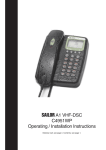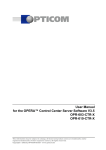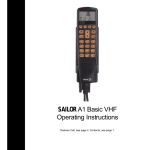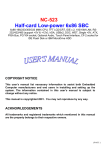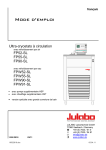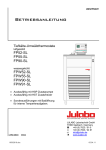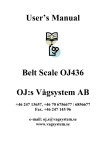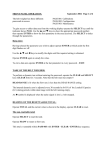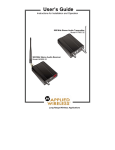Download SAILOR C4900/C4901 Installation Manual
Transcript
SAILOR C4900/C4901 Installation Manual Introduction SAILOR Disclaimer The communication products and systems of Thrane & Thrane are recognized under the brand name SAILOR. The Sailor name has become a guarantee of reliable and technologically superior radio equipment, ranging from basic VHF units to satellite systems and complete compact GMDSS solutions. Any responsibility or liability for loss or damage in connection with the use of this product and the accompanying documentation is disclaimed by Thrane & Thrane. The information in this manual is provided for information purposes only, is subject to change without notice, may contain errors or inaccuracies, and represents no commitment whatsoever by Thrane & Thrane. This agreement is governed by the laws of Denmark. Training certification Training of deck officers to meet the requirements within the concept of GMDSS, as to operation of equipment and basic understanding of the systems, is an extremely important factor for the overall successful implementation of GMDSS. As a unique initiative for GMDSS solutions, we can supply a complete software training programme for on-board training, to be used as preparation in order to fulfil the GMDSS requirements for obtaining the General Operation Certificate. Service A world-wide Sailor GMDSS certified service concept has been established in order to provide the shipping industry with a highly professional and uniform level of service. The Sailor GMDSS Certified Servide Centre concept, which is constantly monitored, ensures that replacement units and spare parts are available at all the Sailor Certified Service Centres around the world. Service centres which are in position along all the major shipping routes. Furthermore the Certified Service Centres ensure that technicians with an annually updated training are ready to provide service 24 hours a day, 365 days a year. Manuals issued by Thrane & Thrane are periodically revised and updated. Anyone relying on this information should satisfy himself/ herself as to the most current version. Providers with access to Thrane & Thrane’s Extranet may obtain current copies of manuals at: http://extranet.thrane.com. Thrane & Thrane is not responsible for the content or accuracy of any translations or reproductions, in whole or in part, of this manual from any other source. Doc. No.: M4900GB0 Issue: F/0738 Maintenance Because of the fact that GMDSS equipment has been installed on board ships in order to meet the SOLAS (Safety of Life At Sea) convention, manufacturers and suppliers of GMDSS equipment have a certain responsibility to secure reliable supplies of equipment and spares in the years to come. Therefore shipowners operating ships both locally and internationally should be fully aware of the importance of fitting GMDSS solutions which will be fully supported by the manufacturer. It is a firm policy of Thrane & Thrane, as the world’s major manufacturer and supplier of GMDSS solutions, that for both the present GMDSS solutions and for future, alternative product solutions, all Sailor GMDSS systems will be entering the next century, in fully parallel production. SAILOR SAILOR R · Porsvej 2 · PO Box 7071 · DK-9200 Aalborg SV · Denmark Phone: +45 9634 6100 · Fax: +45 9634 610 E-mail: [email protected] · Web: www.sailor.dk C4900/01 Installation Contents 2 2.1 2.2 2.3 2.3.1 2.3.2 2.3.3 2.4 2.4.1 2.4.2 2.5 2.6 2.6.1 2.7 2.8 2.8.1 2.8.2 2.8.3 2.8.4 2.8.5 0010 Installation .......................................................................................................................................................... Mounting Possibilities ........................................................................................................................................... Power Supply ....................................................................................................................................................... Handset Connection - A1 VHF-DSC/Basic VHF .................................................................................................. Connection of Transceiver / Indoor Handset ....................................................................................................... Connection of Transceiver / WP SPARC-Bus Connection Box / Weatherproof Handset ................................................................................. Connection of Transceiver / Indoor and Weatherproof Handset ......................................................................... Handset Connection - VHF-DSC ......................................................................................................................... Connection of Transceiver / Indoor and Weatherproof Handset ......................................................................... Connection of Transceiver / Connectionbox H4991 / Indoor and Weatherproof Handset ....................................................................................................................... Loudspeaker Connection ..................................................................................................................................... Connectors ........................................................................................................................................................... SPARC-Bus Cable ............................................................................................................................................... Installation of Handset .......................................................................................................................................... System Function Test ........................................................................................................................................... Test Procedure System Priorities: (System Control and SPARC-Bus Data Interface Circuits) ................................................................................. Test Procedure Intercom: (Handset TX AF Circuits and Handset Audio Amplifier Circuits) ......................................................................... Test Procedure TX Transmitter: (Handset TX AF Circuits and VHF Transmitter) ................................................................................................... Test Procedure VHF Signal Reception: (VHF Receiver and Handset RX AF Circuits) ...................................................................................................... Test Procedure TX/RX DSC Call ......................................................................................................................... 2 2 2 3 3 4 5 6 6 7 8 8 9 10 12 12 15 17 19 20 1 C4900/01 Installation 2 Installation 2.1 Mounting Possibilities Handset Drilling Plan 2 x ø4.5 ø12 for cable entry CALL ALARM min. 300 Space for handset access min. 200 68.5 Space for cable and handset cable 52.5 144 123 209 TX 1W US 66.5 34 13.5 4-0-35556 4-0-36247 Weight: Handset 2.2 0.5 kg Power Supply The handset unit is supplied from the SPARC-bus interface with +12V-DC. The +12V-DC supply is fused in the handset by a 630 mA fuse. 2 9915 C4900/01 2.3 Installation Handset Connection - A1 VHF-DSC/Basic VHF Remote control units can be connected in two ways: 1. Directly between the transceiver and the control unit hooks. 2. By means of a SPARC-bus connection box H4991 or WP SPARC-bus connection box. Both control units with or without DSC can be connected. Remote speaker may be connected to remote hooks, or to be connection box H4991or WP SPARC-bus connection box. The max. number of handsets allowed to be connected simultaneously to the transceiver without DSC are 4 handsets and to the transceiver with DSC are 7 handsets. 2.3.1 Connection of Transceiver / Indoor Handset Indoor TX 1W US CALL ALARM Transceiver X1 56.114 37389 WARNING: Do not connect the spiral cable for the intelligent handset directly to the transceiver. The spiral cable for the intelligent handset must be connected to the handset hook; otherwise the transceiver may activate distress. 0025 3 C4900/01 Installation 2.3.2 Connection of Transceiver / WP SPARC-Bus Connection Box / Weatherproof Handset Indoor Outdoor TX 1W US CALL ALARM WP Transceiver X1 WP SPARC-Bus Connection box 737216 37390 10m cable supplied by the factory When connecting the sub-D plug, it is possible to avoid making a big hole in the bulkhead of the ship by installing a WP SPARC-Bus connection box between the transceiver and the handset as illustrated here. WARNING: Do not connect the spiral cable for the intelligent handset directly to the transceiver. The spiral cable for the intelligent handset must be connected to the handset hook; otherwise the transceiver may activate distress. 4 0025 C4900/01 2.3.3 Installation Connection of Transceiver / Indoor and Weatherproof Handset If the existing handset hook is the one shown in the drawing below, your weatherproof handset is to be connected as follows. Indoor Outdoor TX 1W US CALL ALARM TX 1W US CALL ALARM WP Transceiver X1 56.114 10m cable supplied by the factory 37391 WARNING: Do not connect the spiral cable for the intelligent handset directly to the transceiver. The spiral cable for the intelligent handset must be connected to the handset hook; otherwise the transceiver may activate distress. 0025 5 C4900/01 Installation 2.4 Handset Connection - VHF-DSC Remote control units can be connected in two ways: 1. Directly between the transceiver and the control unit hooks. 2. By means of a SPARC-bus connection box H4991 or WP SPARC-bus connection box. Both control units with or without DSC can be connected. Remote speaker may be connected to remote hooks, or to be connection box H4991or WP SPARC-bus connection box. The max. number of handsets allowed to be connected simultaneously to the transceiver with DSC are 6 handsets. Always connect local handset to the transceiver. DSC Class of intelligent handset is “D” even if the radio is Class A. 2.4.1 Connection of Transceiver / Indoor and Weatherproof Handset Indoor Outdoor TX 1W US CALL TX 1W US ALARM Transceiver CALL ALARM WP 12V DC Rx / Tx SPARC-BUS OPTION HANDSET PRINTER 56.114 10m cable supplied by the factory 35406C WARNING: Do not connect the spiral cable for the intelligent handset directly to the transceiver. The spiral cable for the intelligent handset must be connected to the handset hook; otherwise the transceiver may activate distress. 0025 6 C4900/01 Installation 2.4.2 Connection of Transceiver / Connectionbox H4991 / Indoor and Weatherproof Handset Indoor Outdoor TX 1W US CALL ALARM TX 1W US CALL ALARM TX 1W US CALL ALARM Transceiver WP 12V DC Rx / Tx H4991 SPARC-BUS OPTION HANDSET PRINTER 56.111 L=1.2m 10m cable supplied by the factory 37395 WARNING: Do not connect the spiral cable for the intelligent handset directly to the transceiver. The spiral cable for the intelligent handset must be connected to the handset hook; otherwise the transceiver may activate distress. 0025 7 C4900/01 Installation 2.5 Loudspeaker Connection When one or more control units are connected to the VHF system, two of them can be set up to use the transceiver’s two loudspeaker outputs to drive external speakers. To link a loudspeaker to a control unit, enter the function menu and select external speaker: Path: Func\general\sound\loudspeak\norm\alarm\extspk, and set external speaker to be 1 or 2 as desired. The loudspeaker signals are available in the SPARC-bus cabling, and a loudspeaker can be connected to the system in the handset hook parts or in the connection box. Connect the loudspeaker cables to SPARC-bus signals (LS_1+ and LS_1-) or (LS_2+ and LS_2-) depending on which speaker selection is made by the control unit(s). 2.6 Connectors Handset Hook SPARC-Bus Connection Box H4991 WP SPARC-Bus Connection box HOOK Connection 32262 V1 X1 S2 V2 X3 15 14 13 12 11 10 R2 R4 X1 S1 R1 R3 X2 LS_1+ 11 12 LS_1- 12 13 -BAT LS_2+ 13 RX_AF- +12VDC 11 S3 RX_AF+ 10 9 9 8 8 X3 7 RX_AF- 10 7 6 9 6 5 8 +12VDC +12VDC LS_1+ 12 LS_1- 13 LS_2+ 15 15 15 -BAT 14 LS_2- 14 LS_2+ 14 5 4 -BAT RX_AF+ 11 4 3 +12VDC AF- 10 3 2 7 9 2 1 6 8 LS_2+ -BAT SPARCAF+ 7 -BAT RX_AF+12 VDC LS _1+ LS _1-BAT AF- SPARC+ 6 LS_1+ LS_1- RX_AF+ AF+ 5 5 +12VDC +12VDC RX _AF+ RX _AF+12 VDC SUPPLY_ON SPARC- 4 AF-BAT -BAT SPARC+ 3 AF+ 4 AF+ 2 SPARC- 3 SPARC- SUPPLY _ON 2 SPARC+ AF- 1 1 SUPPLY _ON SPARC+ SUPPLY _ON 1 Term. ON LS_2- LS_2- Shield LS_2- NC X2 37394 35349A 35348 In the handset hook the shield of the SPARC-bus cable is connected to the cable relief. WARNING: Be carefull not to cover the distress switch with installation wires. 8 0010 C4900/01 Installation 2.6.1 SPARC-Bus Cable The table below describes the max. length of the SPARC-bus cable for the power supply for one handset unit. The length of the cable depends on the number of supply wires and the wire thickness. The table shows the cable lengths for systems with a supply voltage of +12V. If the system supply voltage is 24V, i.e. the supply voltage is provided through N420, the max. cable length listed in the table may be doubled. Number System supply +12 Volt +12 Volt +12 Volt +12 Volt 56.114 Number of wires in cable 2x8 2x8 2x8 2x8 From To BOX BOX BOX Transceiver HOOK HOOK HOOK HOOK Wire mm2 0.25 0.50 0.75 0.14 Number of wires Number of wires - BATT OVDC +12VDC 2 2 2 2 2 2 3 2 Max. length 30 metres 60 metres 100 metres 5 metres The SPARC-bus cable length is limited by the level of output power delivered to a connected external speaker on the LS_2 terminals. The speaker output power depends on cable length and cable thickness as described in the table below. Wire [mm2] 0.14 0.25 0.25 0.50 0.50 0.75 0.75 Length [m] 5 10 20 20 40 30 60 Max. Power [W] 3.4 3.2 2.0 3.2 2.0 3.2 2.0 56.114 35356 SPARC-bus/Option cable 5 metres 56.114 Pin no. pin 1 pin 2 pin 3 pin 4 pin 5 pin 6 pin 7 pin 8 pin 9 pin 10 pin 11 pin 12 pin 13 pin 14 pin 15 Shield 0738 Name SUPPLY_ON SPARC+ SPARCAF+ AF-BAT_0VDC +12VDC RX_AF+ RX_AF+12VDC LS_1+ LS_1-BAT_0VDC LS_2+ LS_2- Colour Twisted pair Red/White 7 Yellow 1 Yellow/White 1 Blue/White 2 Blue 2 Red and Orange 7/8 Orange/White 8 Green/White 3 Green 3 Black/White 6 Brown 4 Brown/White 4 Black 6 Purple 5 Purple/White 5 Shield SPARC-bus connections Transceiver unit X1 pin 1 pin 2 pin 3 pin 4 pin 5 pin 6 pin 7 pin 8 pin 9 pin 10 pin 11 pin 12 pin 13 pin 14 pin 15 Name Twisted Handset pair HOOK X1,X3 SUPPLY_ON 1 SPARC+ 1 2 SPARC1 3 AF+ 2 4 AF2 5 -BAT_0VDC 6 +12VDC 7 RX_AF+ 3 8 RX_AF3 9 +12VDC 10 LS_1+ 4 11 LS_14 12 -BAT_0VDC 13 LS_2+ 5 14 LS_25 15 SPARC-bus connection box X1,X2,X3 1 2 3 4 5 6 7 8 9 10 11 12 13 14 15 9 C4900/01 Installation 2.7 Installation of Handset 0. VHF system turned off, connect hook and handset to the system according to the above description. 1. When transceiver, SPARC-bus cable and handset hook unit are assembled, connect the handset to the hook by the 15-pole D-sub connector and place the handset on hook. 2. Turn the VHF system on by pressing the ON/OFF button at the top of the handset. 3. Set up the handset SPARC-bus location number and SPARC-bus handset name by entering the service menu in the handset: ___ Press FUNC TELEPHONY ___ Press arrow down FUNC SERVICE ___ Press FUNC * Key in the acces code (Alter the key until the digit appears) ___ SELECT FUNC 9876> Press ___ FUNC BUS SETUP Press ___ FUNC HANDSET 10 0010 C4900/01 Installation Press Use ___ to change SPARC-bus location number SELECT FUNC LOC NO 1 Press Use keys to to ___ enter/change name of handset. Press to step one character FUNC NAME * to the right or select the entered name. After setup enter VHF mode by pushing: or 16 MEM VOL SQ 0 08 05 4. If an external speaker has to be linked to the handset: - Enter the function menu and select external speaker as desired. - Path Func\general\sound\loudspeak\norm\alarm\extspk - Display: ___ - Use to change type of EXT. speaker SELECT FUNC EXT SPK * 0: No external speaker selected 1: External speaker 1 selected 2: External speaker 2 selected 3: Both external speakers selected - Use 0010 to select the setting 11 C4900/01 Installation 5. ATTENTION: When more control units are connected to the VHF system, they all have to be assigned different location numbers for the system to function correctly. The control unit placed at a ship’s main place of control should be assigned location number 1. In the VHF system the control unit which has location number 1 also has the highest priority in the system and is thus able to control the system at any time. 2.8 System Function Test When a handset has been connected to the VHF system, go through the following test procedures to ensure correct system function. If the test items are performed succesfully the VHF system functions correctly. Purpose: Test setup: 2.8.1 To test correct assembly of the system, ensuring SPARC-bus command communication between all system units, including system control priorities for the control units. Check the telephony TX LF and RX LF routing. Turn on all control units, all handsets placed on hook, each unit showing VHF display. Test Procedure System Priorities: (System Control and SPARC-Bus Data Interface Circuits) If only one control unit is connected, just hook off the handset and change the channel or push PTT once to ensure that the handset is able to control the system. If more control units are connected, do the following: Test stimuli Expected result 1a Handset loc_1: VHF display. Handset (loc_1): Hook off. 16 MEM VOL SQ 0 08 01 Other control units: OCC display. oCC 1 “NAME” 12 0010 C4900/01 1b Other control units in sequence: Hook off. Installation Handset loc_1: VHF display. 16 MEM VOL SQ 0 08 01 Other control units: OCC display. oCC 1 “NAME” 2 All control units: Hook on. All control units: VHF display (system idle). 16 MEM VOL SQ 0 08 01 3a Handset (loc_2): Hook off. Handset loc_2: VHF display. 16 MEM VOL SQ 0 08 01 Other control units: OCC display. oCC 2 “NAME” 3b Handset (loc_1): Hook off. Handset loc_1 or loc_2: VHF display. 16 MEM VOL SQ 0 08 01 Other control units: OCC display. oCC 1 “NAME” 0010 13 C4900/01 Installation 3c Handset (loc_1): Hook on. Handset loc_2: VHF display. 16 MEM VOL SQ 0 08 01 Other control units: OCC display. oCC 2 “NAME” 3d Handset (loc_3): Hook off. Handset loc_2: VHF display. 16 MEM VOL SQ 0 08 01 Other control units: OCC display. oCC 2 “NAME” 3e Handset (loc_3): Hook on. Handset loc_2: VHF display. 16 MEM VOL SQ 0 08 01 Other control units: OCC display. oCC 2 “NAME” 3f Handset (loc_2): Hook on. All on hook. All control units: VHF display (system idle). 16 MEM VOL SQ 0 08 01 If the different control units do not act as described, it is possible that some of the units are assigned the same location number; if so, check the location number setup in each unit. 14 0010 C4900/01 2.8.2 Installation Test Procedure Intercom: (Handset TX AF Circuits and Handset Audio Amplifier Circuits) If only one control unit is connected, this test is not to be carried out. If more control units are connected, do the following: Test stimuli Expected result 1 Handset (loc_1): INT-C dial display and dialling tone in the handset. Handset (loc_1): IC2 CALLING Handset (loc_2): INT-C dial display and dialling tone in the handset. IC1 CALLING Other control units: VHF display. 16 MEM VOL SQ 0 08 01 2 Handset (loc_1): Hook off. Handset (loc_1): INT-C dial display and dialling tone in the handset. IC2 CALLING Handset (loc_2): INT-C dial display and dialling tone in the handset. IC1 CALLING Other control units: VHF display. 16 MEM VOL SQ 0 08 01 0010 15 C4900/01 Installation 3 Handset (loc_1): Press PTT and talk. Handset (loc_1): INT-C dial display and dialling tone in the handset. IC2 CALLING Handset (loc_2): Voice output in speaker and dialling tone in the handset. IC1 CALLING Other control units: VHF display. 16 MEM VOL SQ 0 08 01 4 Handset (loc_2): Hook off. Handset (loc_1): INT-C display. IC2 Handset (loc_1): INT-C display. Intercom in progress, talk both ways. Voice in both handset earpieces/speakers. “NAME 2” IC1 “NAME 1” 16 Other control units: VHF display. MEM VOL SQ 0 08 01 5 Handset (loc_1): Hook on. Handset (loc_2): VHF display. 16 MEM VOL SQ 0 08 01 Other control units: OCC display. oCC 2 “NAME” 16 0010 C4900/01 6 Installation Handset (loc_2): Hook on (all on hook) All control units: VHF display (sys idle). 16 MEM VOL SQ 0 08 01 2.8.3 Test Procedure TX Transmitter: (Handset TX AF Circuits and VHF Transmitter) When this test is carried out, the transmitter power level has to be 25W indicated by no light in the 1W indicator lamp. If the VHF transmitter fails, the 1W indicator lamp will go on during PTT push and/or the display will show the error message ANTN FAIL. This is not the expected result. If ANTN FAIL is displayed, check that the aerial and aerial cable are connected correctly. Test stimuli Expected result 1 Handset (loc_1): VHF display. Handset (loc_1): Hook off. 67 MEM VOL SQ 0 08 01 Other control units: OCC display. oCC 1 “NAME” 0010 17 C4900/01 Installation 2 Handset (loc_1): Press PTT. Handset (loc_1): VHF display. TX indicator lamp is lit. 67 MEM VOL SQ 8 08 01 Other control units: OCC display. oCC 1 “NAME” 3 Handset (loc_1): Release PTT. Handset (loc_1): VHF display TX indicator lamp turns off. 67 MEM VOL SQ 0 08 01 Other control units: OCC display. oCC 1 “NAME” 4 Handset loc_(1): Hook on. All control units: VHF display (system idle). 67 MEM VOL SQ 0 08 01 18 0010 C4900/01 Installation 2.8.4 Test Procedure VHF Signal Reception: (VHF Receiver and Handset RX AF Circuits) For each control unit, do the following: Test stimuli Expected result 1 All control units: Receiver opens, static noise in all control unit speakers. If no sound, activate the speaker and turn up the volume level. All handsets placed on hook. (VHF display) Set squelch threshold level to 0. 67 MEM VOL SQ 0 08 01 0010 19 C4900/01 Installation 2.8.5 Test Procedure TX/RX DSC Call To test the system’s DSC functionality, enter the function menu and perform two test calls: (INTernal test) and (EXTernal test). Internal test call: (The call is looped back internally, no activation of transmitter or receiver) This test controls the DSC modem in the transceiver RX and TX internally. 1. Hook off handset. 2. Enter function menu: Func\dsc\testcalls\int path. Select call by “arrow right” key. 3. “Transmit” the call by keying “Send call”. 4. The display will show in sequence: TX-CALL, TX-OK. 5. The call is announced by the DSC modem. Read the call info in RX-LOG. External test call: (The call is transmitted and received using the aerials). This test also controls the hardware of transmitter and receiver boards. 1. Hook off handset. 2. Enter function menu: Func\dsc\testcalls\ext path. Select call by “arrow right” key. 3. “Transmit” the call by keying “Send call”. 4. The display will show in sequence: TX-CALL, TX-OK. 5. The call is announced by the DSC modem. Read the call info in RX-LOG. 20 0010 SAILOR SAILOR R · Porsvej 2 · PO Box 7071 · DK-9200 Aalborg SV · Denmark Phone: +45 9634 6100 · Fax: +45 9634 610 E-mail: [email protected] · Web: www.sailor.dk
























